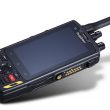Public safety applications for 802.11b
802.11b: Don’t let the jargony name scare you. In plain English, 802.11b merely describes the standard for transmitting data at speeds as high as 11Mbps, on the unlicensed 2.4GHz band.
802.11b wireless technology is special for two reasons. First, it makes it possible to extend a high-speed network quickly because wires do not have to be installed. Second, 802.11b is relatively cheap compared to the expense of adding T1 or even lower-speed ISDN lines.
“For minimizing infrastructure between buildings, 802.11b is so much more cost-efficient compared to T1 or ISDN,” said William A. “Sam” Smith, a systems analyst with the city of Lawrence, KS. “With 802.11b, you can establish a link between buildings with 4MB throughput for about $3,000 and you own the infrastructure.”
But that’s not all 802.11b can do, as the Lawrence, KS, Police Department has discovered. By creating 802.11b links between its wired wide-area network and 14 LKPD cruisers (plus four more owned and operated by the University of Kansas), the LKPD has given its patrol cars the same connectivity found in the station house.
Strategic considerations
The only downside? Due to budget constraints, not all of the LKPD’s cruisers are equipped with 802.11b transceivers and hardened Panasonic laptops. As a result, “at a shift change, our officers run out to get a car that has a laptop,” said Lt. David L. Cobb, who heads the LKPD’s Information Technology department. “It’s a shift supervisor’s dream.”
For the LKPD, maximizing resource use is a must. “We are a lean department,” said Cobb. “We are under the 1.5 officers-per-thousand-population national average. In fact, Lawrence only has 0.75 officers per thousand.
“As a result, we find ourselves going from call to call,” he added. “To cope, we’re trying to stretch what our officers can do. That’s why we try to keep them out in the field, so that our response times are faster.”
This is where 802.11b makes such a difference. Rather than losing precious time writing reports at the station, LKPD officers can compile them in their cars. After all, “when they do come to the station, it takes time to park the car, walk up the steps to the second floor, sit down and maybe get interrupted,” Cobb said. “As a result, each officer uses up a minimum of 20 minutes per station visit, without actually getting any work done.”
Ironically, the LKPD didn’t initially adopt 802.11b to solve this problem. Instead, it chose wireless networking when the department was split into two separate locations.
“We were all in one center until a year ago,” Cobb said. “Then the city purchased a building in the west end. Today, the chief of police, the training department and the detectives have moved to that building. Meanwhile, the patrol division, technology and evidence are in the old building at 111 E. 11th.”
Tactical realities
For the LKPD, it was vital to have connectivity between our two sites. “When they moved out last year, we had the daunting task not only of duplicating phone lines, but paying for it,” Cobb said. Well, the city is on a tight budget; we couldn’t afford to physically duplicate our wired networks. That’s why we went to 802.11b instead.”
To provide the LKPD with 802.11b connectivity, the department has installed eight towers throughout the region, with nine “bridges” to connect the 2.4GHz portals to the LKPD WAN.
“The network is built on Cisco Aeronet equipment,” Smith said. “The bridges are Cisco 340 bridges. For each site, you need a 42-inch omni antenna with 12dB gain, cabling, amplifier, UPS, timer and a box to put it all in — plus a galvanized steel pole, of course, to attach the antenna to.”
As for the all-important cost? This is where 802.11b really comes through for the LKPD.
“The outside figure on each tower is $4,000 per tower,” Smith said. “For each vehicle, 802.11b technology is $1,500 plus the cost of the laptop. Finally, the firewall technology — which keeps outsiders from using the wireless portals to hack into our WAN — works out to about $3,000 to $4,000 per site.”
Smith said that every last piece was off-the-shelf commodity equipment. “Which is both a benefit and a problem. With off-the-shelf equipment, the price is driven down. But because of that, and because there is so much equipment out there, it is susceptible to attack. If you don’t have it set up properly, it is possible to break into it.”
So the department uses inherent wireless equivalency protocol encryption with the 802.11b units. “We treat that infrastructure as being external to our network,” Smith said. “We’ve put firewalls between it and the department; officers have to log in using passwords, in order to get access, as well.”
Pros …
For LKPD officers equipped with Panasonic laptops and 802.11b access, the daily grind has become significantly easier.
It’s not just the convenience of writing reports in their cars, rather than back at the office. What really makes 802.11b powerful for patrol cars is the connectivity it provides.
With this technology, “officers in cars can look up cases and phone numbers or go to the Internet,” Smith said. “They have all of their resources in the car as they would have in a ‘traveling office.’
“Another benefit comes from being able to call up mug shots,” Cobb said. “ If a suspect swears it isn’t him, the officer can walk him back to see the photo on the laptop and say, ‘Actually, this is you.’”
Officers also have instant access to bulletins that they can look up daily. “They can also take photos and load them into the host computer, and download photos to the laptop without coming into the station, using the digital photo linkup,” Cobb said.
… And cons
Of course, no system is perfect, and 802.11b is no exception.
Its major limitation is range. Under ideal conditions, the most one can hope for is one-quarter to one-half mile’s worth of coverage.
“If you’re using the conventional power of the bridges, you’re limited to 100mW,” Smith said. “You can amplify those to 1W, but that still limits you to quarter to half-mile radial line of sight. That’s unlike a data stream on an 800MHz system, which would cover an entire area.”
To make things tougher, “802.11b signals at 2.4GHz are absorbed by water,” Smith said. “Any water-bearing object in the path cuts the signal, including rain.”
802.11b is worth considering
Limitations aside, the LKPD is still pleased with 802.11b and so are its police officers.
“We have no formal research,” Cobb said. “But the officers seem happy with what they have.”
So is 802.11b worth considering for your department? Yes. It offers a range of advantages at an affordable cost.
One added bonus: “We have some secrets we won’t publicize that might help other departments to make the technology work for them,” Cobb said. “They can contact us by emailing [email protected].”
For public safety network users — and the people who sell them equipment — 802.11b’s time has definitely come.
Careless is a freelance telecommunications writer based in Ottawa, ON, Canada. His email address is [email protected].












